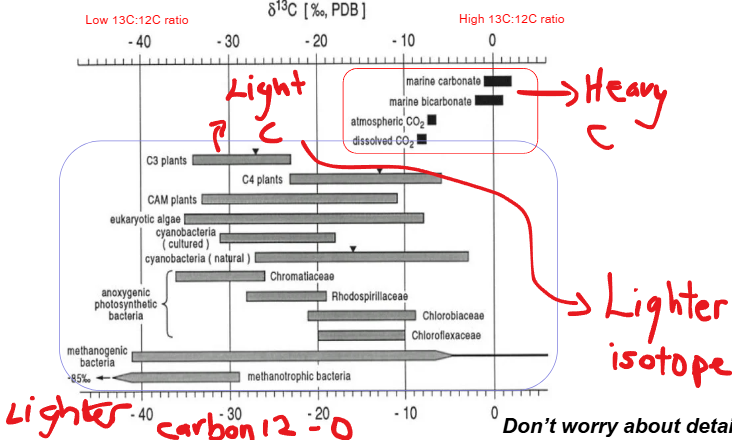GEOL10060 Part C SAMPLE QUESTIONS
1/36
There's no tags or description
Looks like no tags are added yet.
Name | Mastery | Learn | Test | Matching | Spaced |
|---|
No study sessions yet.
37 Terms
Which of the following is not one of the principal nutrients that organisms require to live and grow
(a) C
(b) P
(c) N
(d) K
(d) K
Which of the following statements about the differences between prokaryotes and eukarytoes is correct?
1 prokaryotes tend to be larger than single-celled eukaryotes
2 all single celled organisms are prokaryotes
3 prokaryotes tend to be more morphologically complex
4 prokaryote cells lack a membrane-enclosed nucleus
(a) only 4 is correct
(b) 3 and 4 are correct
(c) only 1 is correct
(d) none are correct
(a) only 4 is correct
The three domains in the tree of life are:
(a) Bacteria, Archaea, Eukarya
(b) Bacteria, Fungi, Plants
(c) Plants, Animals, Bacteria
(d) Plants, Archaea, Eukarya
(a) Bacteria, Archaea, Eukarya
The origin of life from non-living matter is:
(a) abiogenesis
(b) spontaneous generation
(c) endosymbiosis
(d) panspermia
(a) abiogenesis
Which of the following is not a property by which the living state is defined?
(a) movement
(b) self-replication
(c) metabolism
(d) containment
(a) movement
One model for the evolution of eukaryotes from prokaryotes is:
(a) the endosymbiotic theory of cell evolution
(b) cell nucleation theory
(c) nucleus duplication theory for cell complexity
(d) imperfect cell duplication theory
(a) the endosymbiotic theory of cell evolution
The boundary between the Hadean and Archaea is at:
(a) 4.0Ga
(b) 4.4Ga
(c) 3.8Ga
(d) 1.2Ga
(a) 4.0Ga
Different stable isotopes of an element are defined on the basis of which of the following:
(a) variation in the number of neutrons in the nucleus of the atom
(b) always more protons than neutrons in the nucleus
(c) different size of electron cloud orbiting the nucleus
(d) a different atomic number
(a) variation in the number of neutrons in the nucleus of the atom
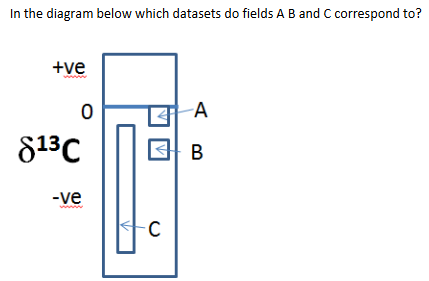
(a) A = marine bicarbonate B = atmospheric Co2 C = living autotrophic organisms
(b) A = atmospheric Co2 B = marine bicarbonate C = living autotrophic organisms
(c) A = = living autotrophic organisms B = atmospheric Co2 C = marine bicarbonate
(d) A = marine bicarbonate B = living autotrophic organisms C = atmospheric Co2
(a) A = marine bicarbonate B = atmospheric Co2 C = living autotrophic organisms
Which of the following is a polymorph of calcium carbonate:
(a) aragonite
(b) struvite
(c) kryptonite
(d) phytolith
(a) aragonite

(a) the fossil is preserved via petrifaction
(b) the fossil is preserved via perimineralisation
(c) the fossil is preserved in pyrite
(d) the fossil is preserved in carbon
(a) the fossil is preserved via petrifaction
Possible evidence for life on Earth at 3850 million years ago is provided by the:
(a) isotope signal of carbon from Akilia Island, Greenland
(b) occurrence of cyanobacteria preserved in chert
(c) fossilised graptolites in sediments in Pilbara craton
(d) filamentous microfossils in volcanogenic massive sulphides at Pilbara craton.
(a) isotope signal of carbon from Akilia Island, Greenland
Which of the following statements about the Great Oxidation Event (GOE) is correct?
(A) detrital pyrite implies an atmosphere rich in free oxygen and is abundant before the GOE
(B) the GOE occurred 1.9 Ga
(C) red beds appear first in the geological record about 2.3Ga
(D) banded iron formations comprise alternating laminae of iron oxides and carbonate
(C) red beds appear first in the geological record about 2.3Ga
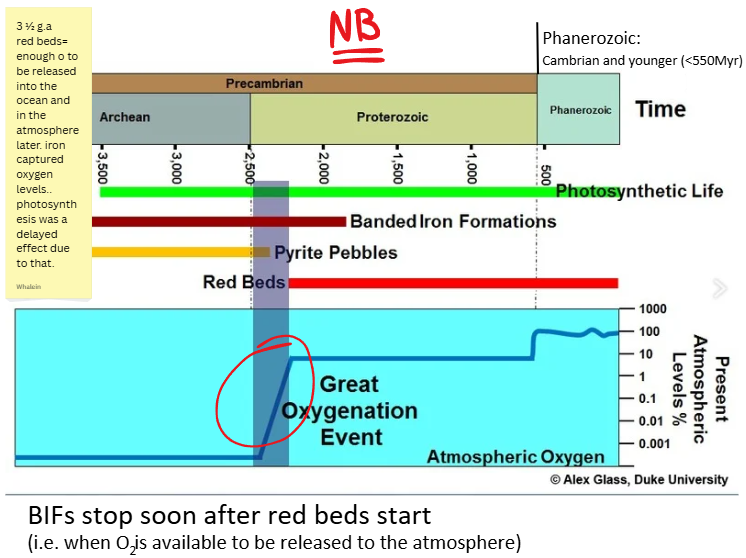
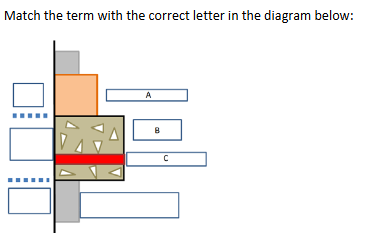
(a) A cap carbonate sequence B glacial deposits C Banded Iron Formations
(b) A diamictite B glacial deposits C Banded Iron Formations
(c) A cap carbonate sequence B Banded Iron Formations C glacial deposits
(d) A cap carbonate sequence B Banded Iron Formations C diamictite
(a) A cap carbonate sequence B glacial deposits C Banded Iron Formations
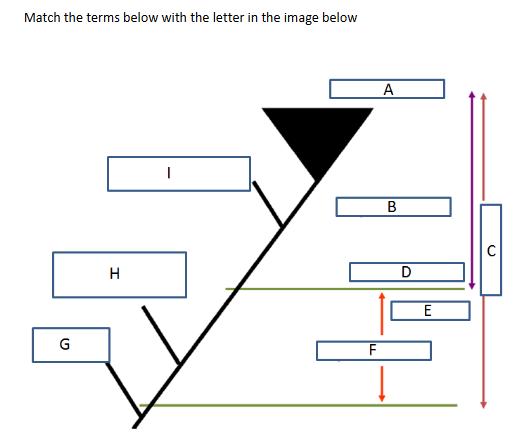
(a) A Protostomes B triploblastic G Porifera I Deuterostomes
(b) A Protostomes B triploblastic G Deuterostomes I Porifera
(c) A Porifera B Deuterostomes G triploblastic I Protostomes
(d) A triploblastic B Protostomes G Deuterostomes I Porifera
(a) A Protostomes B triploblastic G Porifera I Deuterostomes
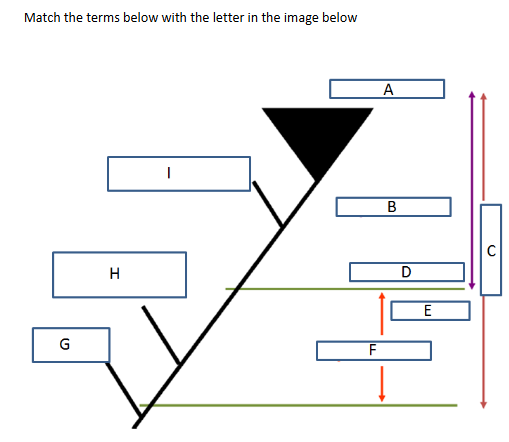
What is the kingdom of animals in order?
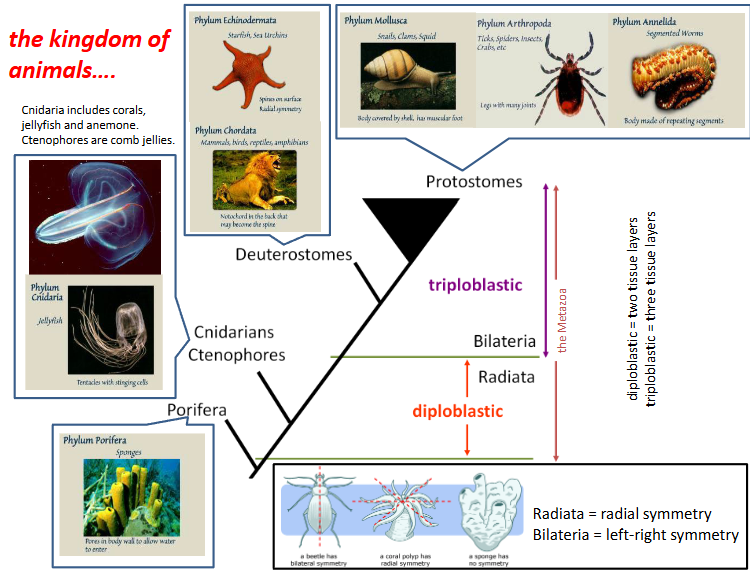
Which of the following groups are examples of protostomes
(a) molluscs arthropods annelids
(b) chinoderms chordates
(c) cnidarians poriferans
(d) ctenophores echinoderms chordates
(a) molluscs arthropods annelids
The internal structure of Vendobionta is known as a
(a) pneu structure
(b) dynamic rebound structure
(c) suevite structure
(d) laminated infill structure
(a) pneu structure
Mass extinctions events are identified by calculating the rate of extinction of which of the following
taxonomic levels
(a) family
(b) genus
(c) order
(d) class
(a) family
A major mass extinction event does not occur at or near the end of which of the following periods in
Earth History
(a) Jurassic
(b) Ordovician
(c) Devonian
(d) Permian
(a) Jurassic
The evidence for impact of a bolide (extra-terrestrial body) with Earth at the K/T boundary includes
elevated abundances of which element:
(a) iridium
(b) kryptonite
(c) calcium
(d) stishovite
(a) iridium
The low water content of tektites suggests which of the following:
(a) formation at high P + T
(b) they were not deposited under water
(c) they were sourced from anhydrous minerals
(d) they melted under water
(a) formation at high P + T
Which of the following pieces of evidence for the impact of a bolide at or near the K/T boundary has
the widest geographic distribution?
(a) shocked quartz
(b) mass wasting deposits
(c) suevite
(d) ejecta blanket
(a) shocked quartz
The stratigraphy of the succession inside the Chicxulub crater has been interpreted differently by various authors. Those authorities who favour two impacts separated by several hundred thousand years interpret the 0.5m thick interval between the suevite and the boundary clay as having originated via
(a) the build-up of marine sediments inside the impact crater between events
(b) the ‘instant’ backwash of water borne sediments into the crater at the time of the second event
(c) collapse of the crater margin after the first event
(d) tsunami deposits from the second event
(a) the build-up of marine sediments inside the impact crater between events
The Siberian Traps were emplaced at or near the end of which period:
(a) Permian
(b) Cretaceous
(c) Devonian
(d) Carboniferous
(a) Permian
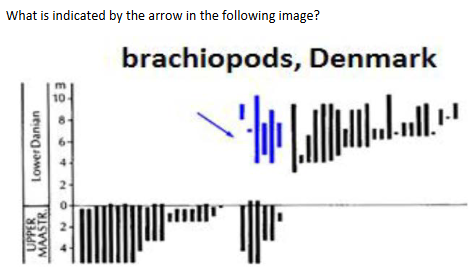
(a) Lazarus taxa
(b) a second mass extinction event
(c) Elvis taxa
(d) newly evolved taxa
(a) Lazarus taxa
Which of the following is correct?
(A) Lazarus taxa can arise via migration of taxa in response to changing environmental conditions
during an extinction event, then their return to the original area
(B) Lazarus taxa can arise by evolution of new taxa that resemble those that go extinct
(C) Lazarus taxa can arise by local extinction during an event and repopulation of the area
subsequently
(D) Lazarus taxa are an artefact when the sampling interval is insufficient to capture the last
appearance datum (LAD)
(a) B and C are correct
(b) D is correct
(c) A and C are correct
(d) A and B are correct
(c) A and C are correct
Trace fossils are:
(a) structures produced by biological reworking of sediments
(b) microscopic in size
(c) an alternative name for chemical residues left after decay of an organism
(d) none of the above
(a) structures produced by biological reworking of sediments
Arrange these terms in descending order of resolution (i.e. from largest unit to smallest)
(a) phylum class order family
(b) order class family phylum
(c) class order phylum family
(d) class phylum order family
(a) phylum class order family
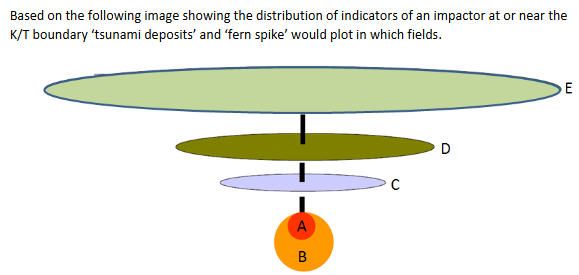
(a) tsunami deposits = D fern spike =E
(b) tsunami deposits = B fern spike =C
(c) tsunami deposits = E fern spike =C
(d) tsunami deposits = A fern spike =B
(a) tsunami deposits = D fern spike =E
Great Oxidation Event (GOE)
~2.4-2.1ga during the Paleoproterozoic era
Caused by cyanobacteria producing O via photosynthesis. Began to accumate in the atmosphere and oceans.
Before GOE: Earth’s atmosphere had little to no O; methane, ammonia and other gases were dominante.
Formation of branded iron formations (BIFs) as oxygen reacted with dissolved iron in oceans.
Mass extinction of many anaerobic (oxygen-intolerant) organisms
May have been a trigger for ‘‘Snowball Earth’’ glaciations due to methane reduction (potent greenhouse gas)
Aerobic life and complex multicellular organisms emerged
Snowball Earth SUMMARY
~635ga
Three main snowball earth events:
Marinoan → 650-635 mya
Sturtian → 730-720 mya
Huronian → 2400-2100 mya (not really accurate but close enough)
Glacial deposits found at low latitudes, dropstones in marine sediments and geochemical markers.
Caused by reduced greenhouse gases and continental shifts/configurations disrupting ocean and atmospheric circulation
High albedo affect from ice reflecting more sunlight, further cooling
Volcanic CO2 buildup caused greenhouse warming, ending glaciations
Rapid warnming and massive weathering changing ocean’s chemistry

Rise of Animals SUMMARY
~600-540 million years ago, during the Ediacaran and early Cambrian periods
Soft-bodied Ediacaran biota: earliest known multicellular life
Cambrian explosion: Rapid diversification of animal phyla around 541 mya
Environmental triggers:
Increased oxygen levels in oceans and atmosphere
Breakup of supercontinents altering ecosystems
Changes in ocean chemistry (calcium availability for shells)
Biological innovations:
Development of tissues, body symmetry, segmentation and shells
Evolution of predation drove arms races and complexity
Fossil evidence: Burgess shale and other lagerstatten show well-preserved Cambrian fauna
Conquest of Land SUMMARY
~500-400 mya, Ordovician to Devonian periods
First Colonizers:
Plants: Non-vascular plants (like mosses) appeared ~470 Mya.
Fungi: Helped plants colonize land through symbiosis (mycorrhizae).
Vascular Plants: Evolved ~430 Mya, allowing growth away from water sources.
Animals:
Arthropods (e.g., millipedes, scorpions) were first animals on land (~450–430 Mya).
Tetrapods (early vertebrates) evolved from lobe-finned fish ~375 Mya.
Adaptations Needed:
Desiccation resistance (e.g., waxy cuticles in plants, tough exoskeletons in animals).
Support structures (e.g., rigid stems, limbs).
Reproduction without water (e.g., spores, amniotic eggs later).
Environmental Impact:
Plants altered the atmosphere (more oxygen, less CO₂).
Soil formation and weathering changed Earth’s surface and climate.
Mass Extinction SUMMARY
Definition: Events where a large percentage of Earth's species go extinct in a geologically short time.
"Big Five" Major Extinctions:
Ordovician-Silurian (~444 Mya):
~85% of species lost.
Caused by glaciation and sea-level fall.
Devonian (~375–359 Mya):
~75% of species lost.
Possibly due to anoxic oceans and plant-driven climate change.
Permian-Triassic (~252 Mya): "The Great Dying":
~96% of marine and 70% of terrestrial species extinct.
Caused by massive volcanic eruptions (Siberian Traps), climate warming, ocean acidification.
Triassic-Jurassic (~201 Mya):
~80% of species lost.
Linked to volcanic activity and climate shifts.
Cretaceous-Paleogene (K–Pg, ~66 Mya):
~75% of species lost, including non-avian dinosaurs.
Caused by asteroid impact (Chicxulub crater) and volcanic activity.
Effects: Reshaped ecosystems, cleared niches, and allowed for evolutionary radiations (e.g., rise of mammals after K–Pg).
Ongoing Concern: Current biodiversity loss is considered by some as a potential sixth mass extinction, driven by human activity
Red - Chemical evidence of life: Black - Fossil evidence
Locality | Age | Data | Evidence |
Jacks Hills Australia | 4100Ma | Carbon isotopes | Stronglu negative σ13C values for graphite in zircon Remember - rocks recycled as grains into younger rocks |
Akilia Island, Greenland | 3850Ma | Carbon isotopes | Strongly negative σ13C values for carbonaceous inclusions in apatite |
Isua, Greenland | 3770Ma | Carbon isotopes | Strongly negative σ13C values for carbonaceous inclusions in apatite |
Stable isotope analysis
